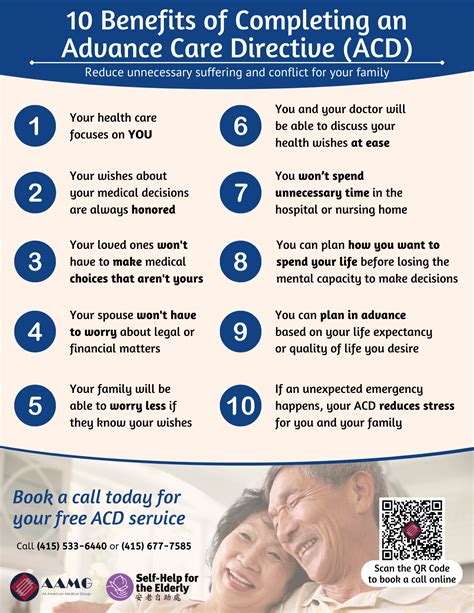Intro
Create a comprehensive Advance Care Directive with 5 expert tips, ensuring your end-of-life care wishes are respected, including living wills, healthcare proxies, and medical power of attorney, for a peaceful and dignified passing.
As people age or face serious health issues, it becomes increasingly important to consider the type of medical care they want to receive if they become unable to make decisions for themselves. This is where an advance care directive comes into play, serving as a vital document that outlines an individual's preferences regarding end-of-life care, medical treatments, and other significant healthcare decisions. Understanding the importance and nuances of advance care directives can empower individuals to take control of their future healthcare, ensuring that their wishes are respected and carried out.
The process of creating an advance care directive involves more than just filling out a form; it requires thoughtful consideration of one's values, beliefs, and priorities. It's a conversation that should involve loved ones, healthcare providers, and sometimes even legal professionals to ensure that the document accurately reflects the individual's desires and is legally binding. The directive can include a range of instructions, from the type of medical interventions that are acceptable to the appointment of a healthcare proxy who can make decisions on the individual's behalf.
Given the complexity and personal nature of advance care directives, it's essential to approach the topic with sensitivity and thoroughness. The following sections will delve into key aspects of advance care directives, offering guidance and insights to help individuals navigate this critical process.
Understanding Advance Care Directives

Advance care directives are legal documents that allow individuals to specify the type of medical care they want to receive if they are unable to communicate their decisions. These documents can include living wills, durable powers of attorney for healthcare, and do-not-resuscitate (DNR) orders, among others. Each component serves a unique purpose, from outlining general healthcare preferences to appointing someone to make decisions when the individual cannot.
Components of Advance Care Directives
- Living Will: A document that outlines the type of medical treatment an individual wants to receive if they become terminally ill or are in a persistent vegetative state.
- Durable Power of Attorney for Healthcare: A document that appoints a healthcare proxy to make medical decisions on the individual's behalf.
- Do-Not-Resuscitate (DNR) Order: A document that instructs healthcare providers not to perform CPR if the individual's heart stops or if they stop breathing.
Benefits of Advance Care Directives

The benefits of having an advance care directive are multifaceted, impacting not only the individual but also their loved ones. By clearly outlining one's wishes, individuals can ensure that their autonomy is respected, even when they cannot communicate. This can reduce the burden on family members and healthcare providers, who might otherwise face difficult decisions without clear guidance.
Some of the key benefits include:
- Reduced Stress and Anxiety: Knowing that one's wishes are documented and will be respected can provide peace of mind.
- Improved Quality of Care: By specifying preferences, individuals can ensure they receive care that aligns with their values and priorities.
- Family Harmony: Advance care directives can prevent conflicts among family members by providing a clear understanding of the individual's desires.
Creating an Advance Care Directive
Creating an advance care directive involves several steps, from understanding the legal requirements in one's state to discussing preferences with healthcare providers and loved ones. It's a process that requires patience, openness, and sometimes the assistance of legal or medical professionals.
- Research State Laws: Advance care directive laws vary by state, so it's crucial to understand the specific requirements and forms needed.
- Choose a Healthcare Proxy: Select someone who is trustworthy, able to make tough decisions, and understands the individual's values and wishes.
- Discuss Preferences: Have open conversations with the healthcare proxy, family members, and healthcare providers about medical treatment preferences and values.
- Complete the Forms: Fill out the necessary forms, which may include a living will, durable power of attorney for healthcare, and DNR order.
- Review and Update: Regularly review the advance care directive and update it as needed to reflect any changes in preferences or circumstances.
Challenges and Considerations

While advance care directives are invaluable tools for ensuring that an individual's healthcare wishes are respected, there are challenges and considerations to be aware of. These can range from the emotional difficulty of discussing end-of-life care to the legal complexities of creating a binding document.
Some of the challenges include:
- Emotional Difficulty: Discussing end-of-life care can be emotionally challenging for both the individual and their loved ones.
- Legal Complexities: Understanding and navigating the legal aspects of advance care directives can be daunting without professional guidance.
- Changing Circumstances: Advances in medical technology and changes in personal values or circumstances may necessitate updates to the advance care directive.
Overcoming Challenges
To overcome these challenges, it's essential to approach the process with sensitivity, patience, and sometimes professional assistance. This can involve:
- Seeking Professional Help: Consulting with attorneys, healthcare providers, or patient advocates can provide valuable guidance and support.
- Open Communication: Encouraging open and honest discussions about end-of-life care preferences can help alleviate emotional difficulties.
- Regular Reviews: Periodically reviewing and updating the advance care directive can ensure it remains relevant and effective.
Advance Care Directives and Technology

The integration of technology into advance care directives is a rapidly evolving field, offering new ways to create, store, and access these critical documents. Digital platforms and electronic health records (EHRs) can enhance the accessibility and portability of advance care directives, ensuring that they are available when needed.
Some of the ways technology is impacting advance care directives include:
- Digital Storage: Secure online repositories where advance care directives can be stored and accessed by authorized individuals.
- Mobile Apps: Applications that allow individuals to create, store, and share their advance care directives directly from their smartphones.
- Electronic Health Records (EHRs): Integrated systems that can include advance care directives, making them readily available to healthcare providers.
Future Directions
As technology continues to advance, it's likely that we will see even more innovative solutions for creating, managing, and accessing advance care directives. These could include:
- Artificial Intelligence (AI): AI-powered tools that can help individuals create personalized advance care directives based on their medical history, preferences, and values.
- Blockchain: Secure, decentralized systems for storing and verifying the authenticity of advance care directives.
Conclusion and Next Steps

Advance care directives are powerful tools that enable individuals to maintain control over their healthcare, even when they cannot communicate. By understanding the benefits, components, and challenges associated with these documents, individuals can make informed decisions about their future care. Whether you're just starting to consider your options or are looking to update an existing advance care directive, the key is to approach the process with openness, patience, and a commitment to ensuring your wishes are respected.
As you move forward, consider taking the following steps:
- Start the Conversation: Begin discussing your preferences with loved ones and healthcare providers.
- Research and Understand: Learn about the legal requirements and options available in your state.
- Seek Professional Guidance: If needed, consult with legal or medical professionals to ensure your advance care directive is comprehensive and legally binding.
By taking these steps and staying informed, you can ensure that your healthcare wishes are respected and that you receive the care that aligns with your values and priorities.
What is an Advance Care Directive?
+An advance care directive is a document that outlines an individual's preferences for medical treatment if they become unable to communicate their decisions.
Why is it Important to Have an Advance Care Directive?
+Having an advance care directive ensures that an individual's autonomy is respected, reduces stress and anxiety for loved ones, and improves the quality of care received.
How Do I Create an Advance Care Directive?
+To create an advance care directive, research state laws, choose a healthcare proxy, discuss preferences with loved ones and healthcare providers, complete the necessary forms, and review and update the document as needed.
We invite you to share your thoughts and experiences with advance care directives in the comments below. Your insights can help others navigate this important process. If you found this information helpful, consider sharing it with friends and family who may be facing similar decisions. Together, we can promote a better understanding of advance care directives and support individuals in taking control of their healthcare futures.
